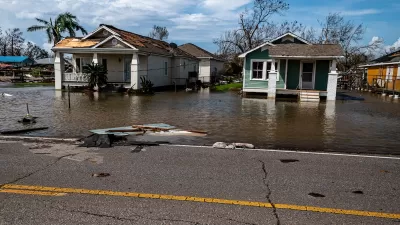Despite efforts to stop them, floods hammered the U.S. in the early 20th century. A now abandoned model of the Mississippi river, its tributaries and surrounding lands was built to better understand how to combat those floods.
"Although the scope of flood control had expanded beyond the Mississippi, the work was limited by current field research methods; engineers found it difficult to track what was being done at various points along the river and thus impossible to predict how isolated "solutions" might affect one other. To understand the Mississippi River Basin as a dynamic system of interconnected waterways, the Corps needed new, more sophisticated scientific tools.
Reybold came up with a radical idea: a large-scale hydraulic model that would enable engineers to observe the interactive effects of weather and proposed control measures over time and 'develop plans for the coordination of flood-control problems throughout the Mississippi River Basin.'"
As Kristi Dykema Cheramie writes in this essay for Places, the model was built and used, but eventually faded from service. It still offers lessons about the intent and impact of water management efforts in the U.S.
FULL STORY: The Scale of Nature: Modeling the Mississippi River

Study: Maui’s Plan to Convert Vacation Rentals to Long-Term Housing Could Cause Nearly $1 Billion Economic Loss
The plan would reduce visitor accommodation by 25,% resulting in 1,900 jobs lost.

North Texas Transit Leaders Tout Benefits of TOD for Growing Region
At a summit focused on transit-oriented development, policymakers discussed how North Texas’ expanded light rail system can serve as a tool for economic growth.

Why Should We Subsidize Public Transportation?
Many public transit agencies face financial stress due to rising costs, declining fare revenue, and declining subsidies. Transit advocates must provide a strong business case for increasing public transit funding.

How to Make US Trains Faster
Changes to boarding platforms and a switch to electric trains could improve U.S. passenger rail service without the added cost of high-speed rail.

Columbia’s Revitalized ‘Loop’ Is a Hub for Local Entrepreneurs
A focus on small businesses is helping a commercial corridor in Columbia, Missouri thrive.

Invasive Insect Threatens Minnesota’s Ash Forests
The Emerald Ash Borer is a rapidly spreading invasive pest threatening Minnesota’s ash trees, and homeowners are encouraged to plant diverse replacement species, avoid moving ash firewood, and monitor for signs of infestation.
Urban Design for Planners 1: Software Tools
This six-course series explores essential urban design concepts using open source software and equips planners with the tools they need to participate fully in the urban design process.
Planning for Universal Design
Learn the tools for implementing Universal Design in planning regulations.
City of Santa Clarita
Ascent Environmental
Institute for Housing and Urban Development Studies (IHS)
City of Grandview
Harvard GSD Executive Education
Toledo-Lucas County Plan Commissions
Salt Lake City
NYU Wagner Graduate School of Public Service



























